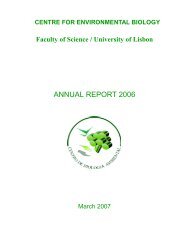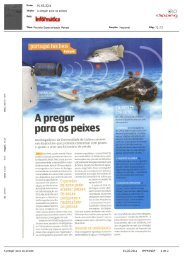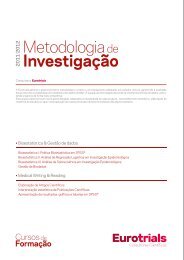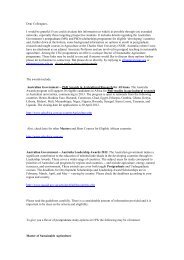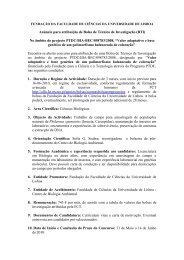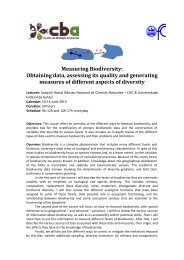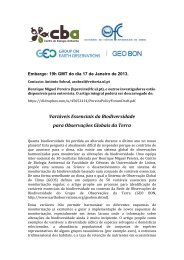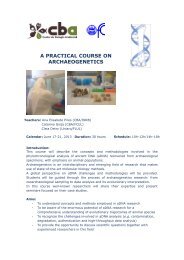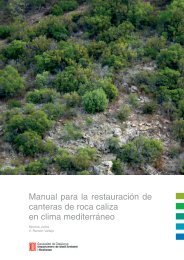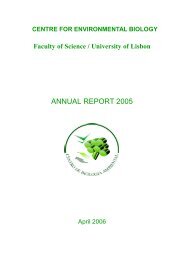European Red List of Vascular Plants - European Commission
European Red List of Vascular Plants - European Commission
European Red List of Vascular Plants - European Commission
You also want an ePaper? Increase the reach of your titles
YUMPU automatically turns print PDFs into web optimized ePapers that Google loves.
Executive summary<br />
Aim<br />
The <strong>European</strong> <strong>Red</strong> <strong>List</strong> is a review <strong>of</strong> the conservation<br />
status <strong>of</strong> c. 6,000 <strong>European</strong> species (mammals, reptiles,<br />
amphibians, dragonflies, butterflies, freshwater fishes, and<br />
selected groups <strong>of</strong> beetles, molluscs, and vascular plants)<br />
according to IUCN regional <strong>Red</strong> <strong>List</strong>ing guidelines.<br />
It identifies those species that are threatened with<br />
extinction at the regional level – in order that appropriate<br />
conservation action can be taken to improve their status.<br />
This <strong>Red</strong> <strong>List</strong> publication summarises results for selected<br />
vascular plants in Europe.<br />
Scope<br />
In Europe, there are more than 20,000 species <strong>of</strong> vascular<br />
plants 1 . This <strong>Red</strong> <strong>List</strong> includes 1,826 selected species <strong>of</strong><br />
vascular plants native to Europe or naturalised before AD<br />
1500. The species selected belong to one or more <strong>of</strong> three<br />
groups:<br />
■■ <strong>Plants</strong> listed under <strong>European</strong> or global policy<br />
instruments such as the Habitats Directive, Bern<br />
Convention, Convention on International Trade in<br />
Endangered Species <strong>of</strong> Wild Fauna and Flora (CITES)<br />
and the EU Wildlife Trade Regulation<br />
■■ Crop wild relatives (CWR) <strong>of</strong> priority crops<br />
■■ Aquatic plant species<br />
Geographical scope is continent-wide, extending from<br />
Iceland in the west to the Urals in the east, and from<br />
Franz Josef Land in the north to the Canary Islands in<br />
the south. The Caucasus region is not included. <strong>Red</strong><br />
<strong>List</strong> assessments were made at two regional levels: for<br />
geographical Europe, and for the 27 current Member<br />
States <strong>of</strong> the <strong>European</strong> Union.<br />
Status assessment<br />
The status <strong>of</strong> all species was assessed using the IUCN <strong>Red</strong><br />
<strong>List</strong> Criteria (IUCN 2001), which are the world’s most<br />
widely accepted system for measuring extinction risk. All<br />
assessments followed the Guidelines for Application <strong>of</strong><br />
IUCN <strong>Red</strong> <strong>List</strong> Criteria at Regional Levels (IUCN 2003).<br />
These assessments were compiled from information from<br />
a large network <strong>of</strong> experts from almost every country and<br />
from an extensive literature review. The assessments were<br />
then completed and reviewed during two workshops<br />
held in Cascais (Portugal) and Brest (France) through<br />
discussions as well as through email correspondence<br />
with relevant experts. Assessments are available on the<br />
<strong>European</strong> <strong>Red</strong> <strong>List</strong> website and data portal:<br />
http://ec.europa.eu/environment/nature/conservation/<br />
species/redlist and http://www.iucnredlist.org/europe.<br />
Results<br />
Three groups <strong>of</strong> vascular plants have been assessed,<br />
totalling 1,826 species among which 467 have been<br />
identified as threatened with extinction. Species listed<br />
in policy instruments have a high number <strong>of</strong> threatened<br />
species with at least 44.9% at <strong>European</strong> and 47.3% at EU<br />
27 level. A further 9.5% are classed as Near Threatened.<br />
This high percentage can be explained with the fact that<br />
this group <strong>of</strong> species had already been identified as being<br />
<strong>of</strong> conservation concern. Of the CWR species assessed, at<br />
least 11.5% are threatened at <strong>European</strong> level and 10.5%<br />
in the EU 27 member states, with another 4.5% that are<br />
Near Threatened. The group <strong>of</strong> aquatic plants shows that<br />
at least 6.6% <strong>of</strong> the species in Europe and 7.2% in the<br />
EU 27 are threatened with extinction. Moreover, 7.4%<br />
are Near Threatened.<br />
By comparison, 44% <strong>of</strong> freshwater molluscs, 37% <strong>of</strong><br />
freshwater fishes, 23% <strong>of</strong> amphibians, 19% <strong>of</strong> reptiles,<br />
15% <strong>of</strong> mammals and dragonflies, 13% <strong>of</strong> birds, and<br />
9% <strong>of</strong> butterflies are threatened, groups that have been<br />
comprehensively assessed in Europe (Cuttelod et al.<br />
2011, Freyh<strong>of</strong> and Brooks 2011, Temple and Cox 2009,<br />
Cox and Temple 2009, Temple and Terry 2007, Kalkman<br />
et al. 2010, BirdLife International 2004a, van Swaay et<br />
al. 2010). Additional <strong>European</strong> <strong>Red</strong> <strong>List</strong>s assessing a<br />
selection from species groups have shown that 20% <strong>of</strong><br />
terrestrial molluscs and 11% <strong>of</strong> the saproxylic beetles are<br />
also threatened (Cuttelod et al. 2011, Nieto and Alexander<br />
2010). No other groups have yet been comprehensively<br />
assessed at the <strong>European</strong> level. Looking at the population<br />
trend, it is noted that 38.4% <strong>of</strong> the policy plants, 15.8%<br />
<strong>of</strong> the aquatic plants and 10.9% <strong>of</strong> the crop wild relatives<br />
1 Source: Euro+Med Plantbase 2006-2011<br />
ix



